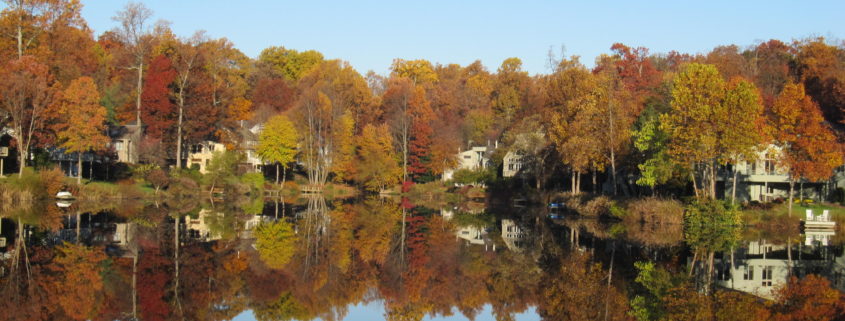Reston joins the Biophilic Cities Network with the help of Virginia Master Naturalists
Doug Britt
In his 1984 book, Biophilia, Harvard ecologist E. O. Wilson popularized the premise that people need contact with nature and that humans are inherently hard-wired for this attraction. Since then, the scientific community has reported that humans derive substantial physiological, psychological, and behavioral benefits from interacting with nature. More recently the concept of biophilia has taken root in the fields of architecture and urban planning.
Building on the concept of biophilia, Dr. Timothy Beatley (Teresa Heinz Professor of Sustainable Communities, School of Architecture, University of Virginia) suggests that, as people across the globe become ever more urban, making life sustainable requires increasing the density and compactness of urban centers to reduce our energy use and carbon footprint. The task of increasing urban density while simultaneously remaining in contact with nature is such a challenge that Beatley argues calls for a different approach to urban design. He suggests creatively incorporating nature into the daily lives of their residents, an activity already underway in many progressive large cities. To this end, he has spearheaded a project that attempts to link such cities together to help them share their experiences and become even healthier and more resilient communities. The resulting Biophilic Cities Network currently has 13 participating cities around the world, with many more in the application stage in an effort to join.
In Virginia, Reston led the way into the Biophilic Cities Network
In 2018, Reston officially became the 13th partner community, joining such biophilic cities as Singapore; Sydney (Australia); Wellington (New Zealand); Oslo (Norway); Edmonton (Canada); Portland; San Francisco; Austin; and Washington, DC. Dr. Beatley presented the Reston Association Board of Directors with the Biophilic Cities Network certificate on 22 March 2018.
In 2017, Reston Association (RA) charged its Environmental Advisory Committee with the task of assessing and documenting the environmental conditions of the community to establish a baseline against which future changes could be measured. Consequently, the Committee formed a nine-member Working Group [the Reston Annual State of the Environment Report (RASER) Working Group] to undertake this task. Among the group members were six Fairfax Chapter VMN program graduates: Doug Britt, Don Coram, Robin Duska, Linda Fuller, Lois Phemister, and Claudia Thompson-Deahl.
The final 2017 RASER was published in July 2017. It evaluated 16 separate environmental attributes of the Reston community, concluding with a postscript arguing that Reston is a biophilic community by design and intent of its founding principles. Reston’s particular way of connecting its natural areas to its residents (through its many walking paths, trails, Nature Center, recreation areas, and education/outreach programs) maximizes such connectivity and promotes more frequent, longer duration, and more immersive interactions. The preservation of Reston’s green spaces also creates healthy viewscapes from much of the built environment.
The RASER authors recommended to the RA Board of Directors that they consider applying for inclusion in the Biophilic Cities Network. The Board accepted the recommendation and tasked the RASER Project Director, Doug Britt, with drafting the application. Britt then contacted Dr. Beatley and explained the many ways Reston manages and monitors its natural resources and promotes connectivity between its residents and its natural areas. Dr. Beatley indicated an application from the RA would be given serious consideration.
How the application process works
The application involves an official resolution by a city’s mayor (or a community’s primary governing body) stating that the community intends to join the Network and become a biophilic partner community. It requires documenting the key ways the community already is biophilic. It requires a statement of goals and aspirations for the future. It also requires specifying at least five different biophilic metrics that will be collected and annually reported.
The successful applicant is expected to share best practices; participate annually in at least one webinar, workshop, or Skype/conference call; respond to requests for assistance from partner communities, if possible; host visits from delegations from other partner cities; attend where/when possible yearly or semi-yearly Biophilic Cities World Conferences; assist individuals and organizational members of the Network; and other expectations consistent with serving as a leader in the Biophilic Cities Movement.
There is a nominal $250 application processing fee, and the applicant must identify an individual to serve as the primary Biophilic Cities Network Coordinator.
Your community may benefit as much as ours has
The benefits include the ability to share best practices, lessons learned, and effective policies with other progressive urban communities. It identifies the community as a leader in the international biophilic movement. And it is designed to promote urban development strategies that improve public health, enhance environmental quality, and create a more resilient and productive community.
Additionally, ever more large corporations are adopting a biophilic philosophy, creating more productive and healthy work environments, and using biophilic architecture to recruit and retain employees in a competitive labor market. Being designated as a biophilic community may help attract such progressive companies, further strengthening a community’s commitment to see its residents connect with nature where they work, live, and play.
There are certainly other communities in the Commonwealth that have biophilic attributes and a desire to protect and enhance their connectivity to nature. It would be wonderful if Virginia could become the first state to have multiple communities designated as partners in the Biophilic Cities Network.
Want to review a resource? We’d love to hear from you. Instructions for submission await your click and commitment.




